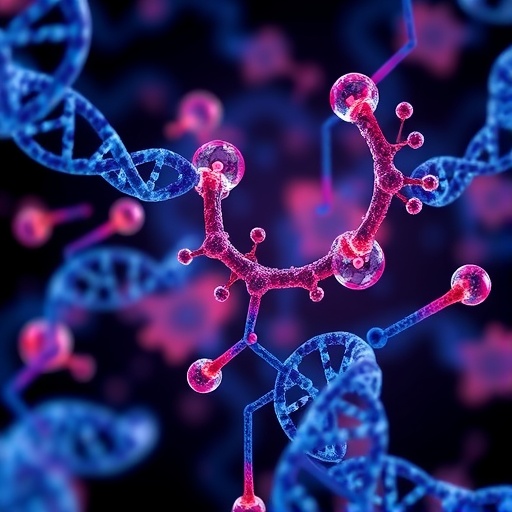In a remarkable stride forward in cancer therapeutics, researchers have unveiled a groundbreaking strategy to target and degrade YAP, a pivotal oncogenic protein, using an innovative nanobody-based bioPROTAC system. This novel approach holds immense promise for inhibiting tumor progression and offers new hope for tackling cancers that have so far eluded effective treatment. At its core, this discovery leverages the precision of bioengineered nanobodies to harness the cell’s own protein degradation machinery, dramatically altering the landscape of targeted cancer therapy.
The protein YAP (Yes-associated protein) functions as a crucial transcriptional co-activator within the Hippo signaling pathway, orchestrating cellular processes like proliferation, apoptosis, and organ size control. Dysregulation of YAP activity is tightly linked with tumorigenesis, driving uncontrolled cell growth and resistance to apoptosis in numerous malignancies. Traditional attempts to inhibit YAP have grappled with its lack of enzymatic activity and the intrinsic difficulty of targeting protein-protein interactions pharmacologically. This new bioPROTAC technology elegantly circumvents these challenges by promoting direct, endogenous degradation of YAP inside cancer cells.
Central to this approach is the concept of bioPROTACs—bifunctional molecules engineered to simultaneously bind a target protein and recruit components of the ubiquitin-proteasome system (UPS), the cell’s natural machinery responsible for degrading unwanted proteins. In this study, researchers have developed a nanobody that exhibits high specificity and affinity for endogenous YAP. By fusing this nanobody with a domain that interacts with an E3 ubiquitin ligase, the chimeric bioPROTAC effectively tags YAP for ubiquitination, marking it for rapid proteasomal degradation.
The molecular architecture of this bioPROTAC is a masterpiece of protein engineering. Nanobodies, derived from the variable regions of heavy chain-only antibodies found in camelids, are prized for their small size, stability, and excellent tissue penetration. Their single-domain nature allows for precise customization and fusion with other functional motifs. Here, the YAP-specific nanobody was linked to substrate recognition elements of an E3 ligase, creating a versatile molecular degrader capable of operating inside living cells without perturbing other essential pathways.
Experimental validation involved introducing the bioPROTAC construct into various cancer cell lines exhibiting hyperactivated YAP signaling. The results were compelling: a significant decline in YAP protein levels was observed within hours of treatment, demonstrating the bioPROTAC’s efficiency in promoting selective degradation. Importantly, this degradation correlated with notable reductions in cancer cell proliferation, migration, and clonogenic potential, all hallmarks of aggressive tumor behavior. These findings underscore the therapeutic potential of bioPROTACs as dynamic tools for modulating the proteome in situ.
Beyond cellular experiments, in vivo analyses further confirmed the impact of this targeted degradation strategy. Mouse tumor models implanted with YAP-driven cancers showed significant tumor volume reduction upon systemic administration of the bioPROTAC molecule. Notably, this occurred without overt toxicity or adverse effects, highlighting the selectivity and safety profile of the approach. The capacity to suppress tumor growth in a living organism marks a substantial advancement toward clinical applications.
The team delved deeper to reveal how the bioPROTAC-modulated YAP landscape triggers downstream effects on cancer signaling pathways. The depletion of YAP engendered a cascade of transcriptional changes affecting genes linked to cell cycle regulation, apoptosis, and tumor microenvironment remodeling. By shifting the cellular equilibrium away from a malignant phenotype, the bioPROTAC not only halts tumor progression but may also sensitize tumors to conventional therapies, opening avenues for combinatorial treatment regimens.
From a biotechnological standpoint, the generation of nanobody bioPROTACs against intracellular targets exemplifies an exciting expansion of the PROTAC paradigm, which has traditionally relied on small molecules. The modular design allows rapid development of tailored degraders for a wide array of previously “undruggable” proteins implicated in diverse diseases. This work positions nanobody bioPROTACs as next-generation precision medicines capable of revolutionizing drug discovery.
Critically, this approach addresses multiple limitations inherent in small-molecule inhibitors, such as off-target toxicity and drug resistance mechanisms. Because bioPROTACs harness the cell’s own degradation system, they not only reduce target protein levels dynamically but also provide a durable therapeutic effect, potentially diminishing tumor relapse risks. Moreover, the antibody-derived recognition confers exquisite specificity, minimizing unintended interactions that often plague chemical inhibitors.
Looking forward, challenges remain concerning the delivery of these biologics in human patients, especially ensuring stability, bioavailability, and immune compatibility. Nevertheless, advancements in nanoparticle carriers, viral vectors, and other delivery modalities are rapidly bridging these gaps. The demonstrated success in preclinical models strongly justifies accelerated efforts toward clinical translation, promising a new era where engineered protein degraders redefine cancer treatment paradigms.
This study also sparks intriguing questions about the broader applicability of nanobody bioPROTACs to other critical oncogenic drivers and non-cancerous pathological conditions. Diseases marked by aberrant protein accumulation or dysregulated signaling—ranging from neurodegeneration to autoimmune disorders—could theoretically be tackled using similar protein degradation strategies. The versatility of nanobody platforms renders this a plausible and highly exciting prospect.
The molecular insights gleaned from this research extend our fundamental understanding of targeted protein degradation mechanisms and deepen appreciation for the complex interplay governing cellular protein homeostasis. By manipulating these pathways with surgical precision, scientists can now envision therapeutic interventions that were once confined to theoretical models. Such progress epitomizes the synergy between synthetic biology, structural biochemistry, and translational medicine.
In conclusion, the pioneering demonstration of YAP-targeting nanobody bioPROTACs heralds a transformative shift in oncology research and treatment. By effectively dismantling a key oncogenic nucleus within tumor cells, this method sets a new benchmark for specificity and efficacy in cancer therapeutics. As this technology matures, it holds the potential to not only improve patient outcomes but also inspire a wave of innovative drug designs targeting the undruggable proteome. The future of precision medicine is rapidly unfolding, and this breakthrough stands at its thrilling forefront.
Subject of Research: Targeted degradation of endogenous YAP protein using nanobody bioPROTACs to inhibit tumor progression.
Article Title: Targeted degradation of endogenous YAP by nanobody bioPROTAC inhibits tumor progression.
Article References:
Zhou, R., Wang, H., Zhang, GM. et al. Targeted degradation of endogenous YAP by nanobody bioPROTAC inhibits tumor progression. Nat Commun 16, 9374 (2025). https://doi.org/10.1038/s41467-025-64426-7
Image Credits: AI Generated




